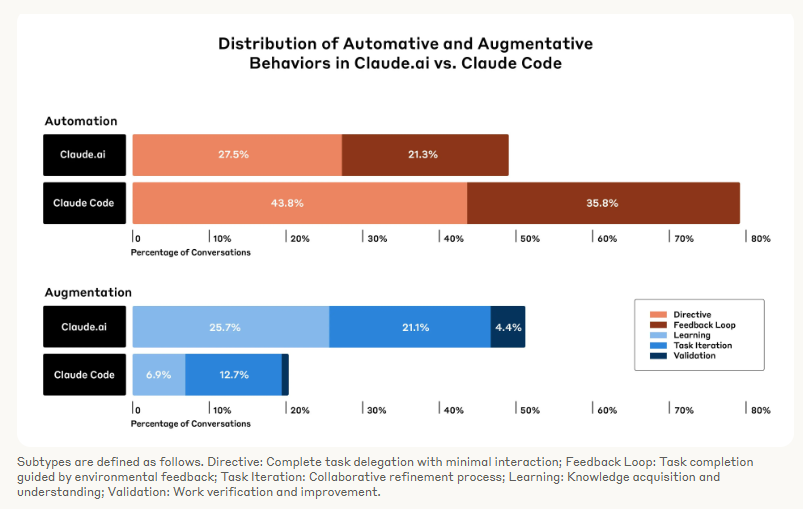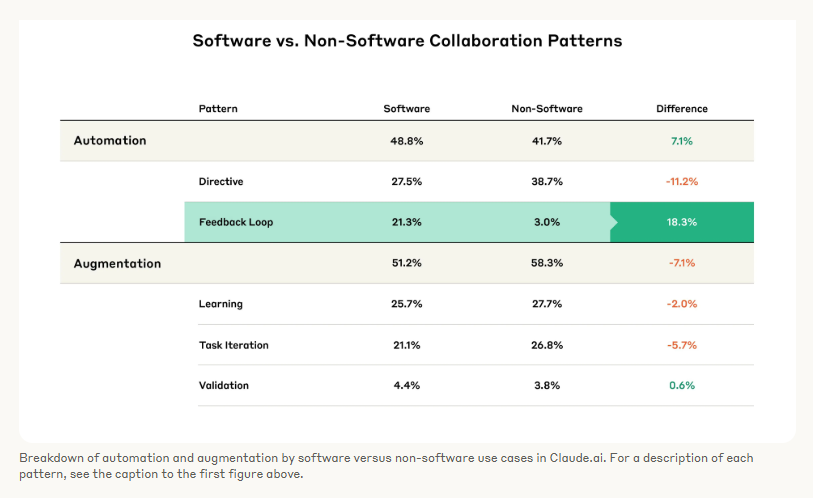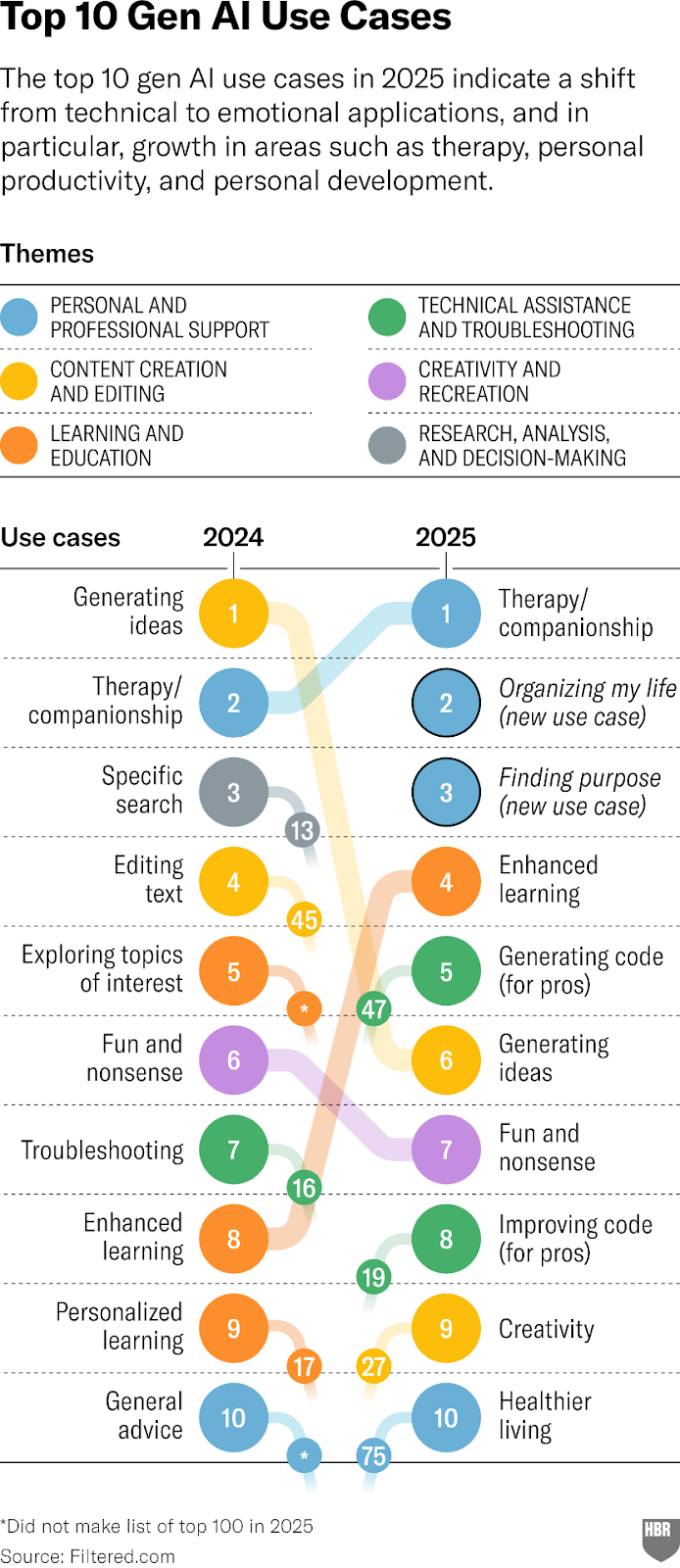Key Takeaways
- AI adoption is diverse and messy, spanning coding automation, personal support and more.
- Focus on actual usage patterns, not just hype, to understand AI's real impact.
- Specialized AI agents are increasingly automating tasks, moving beyond simple assistance.
- Startups and agile teams often lead adoption, highlighting the need for enterprise agility.
- Leaders must enable experimentation and task-level integration rather than waiting for a single "perfect" strategy.
Enough already with the breathless predictions and sci-fi scenarios about AI. For leaders trying to navigate the now, the real question isn't about sentient robots. It's much simpler yet infinitely more complex: What are people actually doing with these tools?
Forget the unified "AI Strategy" you think you're waiting for. The revolution isn't arriving as a neat package. It's infiltrating. Task by task. User by user. Sometimes secretly, sometimes strangely.
New data gives us a raw, unfiltered look under the hood — from hardcore coding agents to AI as a therapist. And guess what? It shows AI usage is broadening, deepening and getting weirder. Leaders clinging to cautious, top-down rollouts are missing the real groundswell. It's time to wake up.
AI Adoption Trends: What Real‑World Data Tells Us Now
Let's get real. We've been awash in AI hype since ChatGPT burst onto the scene. But behind the noise, a more critical question has lingered: beyond the parlor tricks and initial experiments, where is the real work happening? Where is the value being generated, and by whom?
Thankfully, we're getting snapshots of reality, moving beyond speculation to data. Recent analyses — like those from AI leader Anthropic focusing on coding in their AI's Impact on Software Development report, and broader surveys like one reported in HBR scouring online discussions — paint a fascinating, fragmented and accelerating picture. It’s a picture that should jolt complacent leaders.
Hands‑Off Coding: AI Executes Tasks, Not Just Suggests
Anthropic drilled into half a million coding interactions. What did they find? A crucial split. When developers used specialized tools like Claude Code, it wasn't just about getting suggestions (augmentation). A stunning 79% of interactions were classified as automation — where AI directly performed tasks. Compare that to 49% for general Claude use.

Think about that. Specialist AI isn't just a helper; it's increasingly an agent, a digital worker executing tasks. This isn't some future state; it's happening now, particularly in coding.
And who's charging ahead? No surprise: startups. They represented a disproportionately high share (33%) of Claude Code usage compared to their overall coding footprint. Why? Agility, necessity and fewer status quo antibodies fighting change. They're using these tools for competitive advantage today. Meanwhile, many large enterprises show resistance, citing security, integration challenges or maybe just old inertia. Leaders, ask yourselves: Is your caution a strategic necessity or a failure of nerve and imagination?

- Real-World Glimpse: The rise of "vibe coding" describing desired outcomes in natural language and letting AI handle implementation is particularly strong in user interface and frontend development. Anthropic suggests this might disrupt frontend roles first. It lowers non-specialists' barriers to building things, accelerating prototyping and experimentation.
- Fact Check: Anthropic's data showed JavaScript and HTML as the most common languages, with UI/UX tasks prominent. This supports the vibe coding observation for user-facing applications.
Related Article: AI Agents at Work: Inside Enterprise Deployments
Personal AI Boom: AI as Organizer, Therapist, Purpose-Finder?
While coding offers a clear B2B use case, the HBR analysis of online discussions reveals a different, perhaps more surprising, trend in reported usage. The top discussed use cases shifted dramatically based on scouring forums like Reddit and Quora. Last year, "generating ideas" was #1. This year? "Therapy and companionship," "Organizing my life," and "Finding purpose" took the top spots.

Okay, let's pause. This HBR study isn't a rigorous quantitative analysis; it reflects what people talk about online. But even accounting for that bias, the sheer dominance of these deeply personal support categories is striking. It suggests AI is filling needs far beyond simple productivity hacks. It's becoming a confidante, an organizer, a guide for some.
Crucially, though, the coding trend echoes Anthropic: "Generating code" and "Improving code" shot up the HBR rankings, reinforcing the surge in AI's development role.
- Thematic Shift: The HBR author grouped use cases and found "Personal and professional support" nearly doubled its share among the top 100 uses, jumping from 17% to 31%. This broad category encompasses everything from therapy to getting general advice, signaling a significant shift in how people interact with AI.
- Enterprise Echo: This trend towards AI providing professional guidance isn't just personal. Consulting firms like McKinsey, EY and others are rapidly adopting AI for research, analysis and internal knowledge, as detailed in reports like a recent piece in Business Insider. They're reporting significant time savings (30% in one McKinsey study, mirroring findings from KPMG's AI Quarterly Pulse Survey of huge jumps in daily AI tool usage).
Your AI Reality Check: Where Is Adoption Really Happening?
So, what does this messy picture — hardcore coding automation, surprising personal uses and accelerating (but selective) enterprise adoption — tell leaders?
- Usage Is Fragmented, Not Monolithic: Stop looking for a single AI strategy or killer app. AI is seeping into workflows in countless ways, driven by individual needs, startup agility and specific functional opportunities (like coding, sales development representatives (SDRs), content creation and internal Q&A).
- Automation Is Real, Not Just Augmentation: AI performs tasks, not just assists, especially with specialized agents. This has implications for workflow design and skill requirements.
- Early Adopters Gain Real Advantage: The gap between startups/agile firms leveraging agents and cautious enterprises is widening — speed and willingness to experiment matter.
- Human-in-the-Loop Remains Key (For Now): In complex areas like coding, humans are still needed for iteration, refinement and handling tasks where AI falls short (Anthropic found 21% of coding involved human feedback loops vs. 3% for non-coding). But this boundary is constantly shifting.
- Mission-Critical Hesitation: Enterprises are still wary of deploying AI agents in high-stakes, must-be-100%-correct areas (healthcare, law, finance, core operations). Interpretability and reliability remain significant hurdles.
Related Article: Don’t Wait for the AI Flood: How to Build Your 'Ark' Now
Integrating AI Across Tasks Beats Perfect Plans
The key takeaway isn't which use case is "winning." It's that AI isn't a single wave hitting the shore; it's thousands of streams finding paths through the landscape of work and life. It’s messy. It's uneven. And it's accelerating.
The trend lines are undeniable:
- Breadth: AI touches everything from highly technical coding to personal needs.
- Depth: Users are moving from simple prompts to complex automation and agentic workflows.
- Speed: Adoption curves, especially for productivity tools and specialized agents, are incredibly steep.
Leadership Playbook: Enable Experimentation, Scale What Works
Leaders waiting for a perfectly defined, top-down AI strategy handed down on stone tablets will be left managing relics. The game now isn't about finding the perfect application; it's about nurturing an organization capable of fluidly, continuously and opportunistically integrating AI capabilities.
- Embrace the Chaos: Recognize that AI adoption will be uneven. Some departments will sprint ahead (like your coders or marketing team), while others lag due to caution or complexity. Your job isn't to enforce uniformity but to enable progress where it's happening and learn from it.
- Lower the Barriers to Experimentation: What can you dismantle in your organization if startups run circles around enterprises partly because they lack enterprise-based hurdles? Create sandboxes, provide access to tools (with guardrails) and empower teams to test AI solutions for their specific pain points.
- Focus on Capability, Not Just Control: Shift from rigid job descriptions to understanding the tasks that create value. Where can AI agents amplify human capability now? Where can they take over drudgery? Use the data points — like Anthropic’s coding analysis or internal usage patterns — to guide this.
- Build the Human Side: As AI takes on more tasks, the premium on human skills like critical thinking, creativity, collaboration and ethical judgment increases. Invest in training your people not just to use AI but also to work alongside it, manage agents and focus on the irreplaceable human elements.
The companies thriving in this new era won't be those with the most polished five-year AI plan collecting dust on a shelf. They will be the ones with the organizational metabolism to sense where AI can add value today — whether it's automating code deployment, streamlining customer service or even supporting employee well-being — and the agility to integrate it quickly.
The real story of AI adoption isn't neat, and it isn't waiting for your permission. It's happening in pockets of innovation, in surprising personal applications and in the relentless drive of early adopters seeking an edge. Your challenge as a leader is not to predict the future perfectly but to build an organization resilient, adaptable and hungry enough to capitalize on AI's messy, unfolding reality. The streams are flowing; it's time to start building canals, not dams.
Learn how you can join our contributor community.
